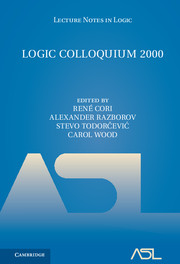Book contents
- Frontmatter
- Introduction
- Contents
- K. Jon Barwise (1942-2000)
- TUTORIALS
- PHOTOGRAPHS
- ARTICLES
- Bounded forcing axioms and the size of the continuum
- Hilbert's wide program
- Rigidity conjectures
- Metapredicative and explicit Mahlo: a proof-theoretic perspective
- A two-dimensional tree ideal
- Psychology looks hopefully to logic
- Russell's logics
- Partitioning pairs of uncountable sets
- Aspects of the Turing jump
- Liouville functions
- References
Hilbert's wide program
from ARTICLES
Published online by Cambridge University Press: 27 June 2017
- Frontmatter
- Introduction
- Contents
- K. Jon Barwise (1942-2000)
- TUTORIALS
- PHOTOGRAPHS
- ARTICLES
- Bounded forcing axioms and the size of the continuum
- Hilbert's wide program
- Rigidity conjectures
- Metapredicative and explicit Mahlo: a proof-theoretic perspective
- A two-dimensional tree ideal
- Psychology looks hopefully to logic
- Russell's logics
- Partitioning pairs of uncountable sets
- Aspects of the Turing jump
- Liouville functions
- References
Summary
Otto Blumenthal's elegant biographical sketch of Hilbert, written in 1922 in celebration of Hilbert's sixtieth birthday, begins with a long discussion of the “Hilbert Problems” address, delivered here one hundred years ago nextmonth. That address, says Blumenthal, epitomizes both Hilbert's manner of working and his personality—the selection of problems that are difficult without being inaccessible; their formulation in terms so clear as to render them intelligible to the average person in the street; and then their solution within an axiomatic system that combines simplicity with full rigor. “Hilbert,” says Blumenthal, “is the man of problems. He collects and solves existing ones and points out new ones. His biography can be recounted in terms of problems. The birth of a man is chance, but his development is his own work.”
Blumenthal then listsHilbert's astonishing range of accomplishments, spanning the entire breadth of mathematics: his early work on invariant theory; his contributions to algebraic number theory; his book on the foundations of geometry; his solution of Waring's Problem and the rehabilitation of the Dirichlet Principle; his work in integral equations and mathematical physics; and one could add his work in logic and proof-theory, large parts of which still lay in the future.
This designation of Hilbert as “theman of problems” neatly catches awidely held view of his mathematical accomplishment. In particular, the standard view of his 1900 Paris lecture sees it as a tour de force of mathematical problem- posing — as it were, the supreme “Mathematical Games and Puzzles” column, but at the highest level of mathematical sophistication, displaying profound insight into the problems that were to guide the development of mathematics in the twentieth century.
This way of understanding the Hilbert Problems address combines readily with three widespread and interrelated assumptions about Hilbert that have collectively become a part of the Hilbert folklore. It would be too strong to call them myths, since each contains a considerable kernel of truth; but, taken together, and without qualification, they present a picture of Hilbert that plays down the interconnections and the philosophical unity of his thought, and that is impossible to reconcile what we now know from his unpublished writings.
- Type
- Chapter
- Information
- Logic Colloquium 2000 , pp. 228 - 251Publisher: Cambridge University PressPrint publication year: 2005



